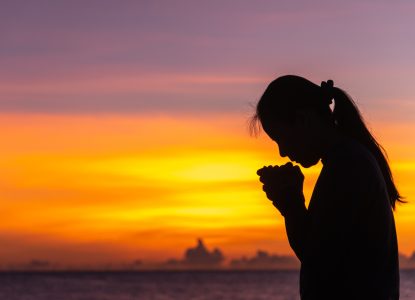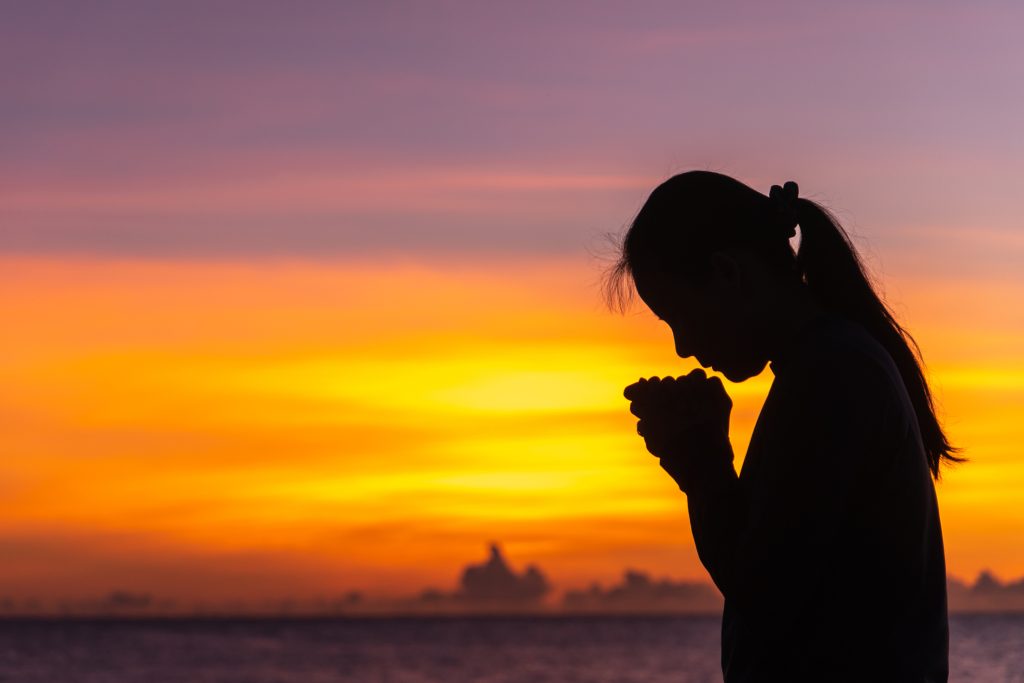By Clair Brown, Arthur Dahl, Yoshinobu Miyake, Sherrie Steiner, and Victoria W. Thoresen; G20 Interfaith Forum Working Group on the Environment
– – –
As evidenced in Part 1 of this two-part essay, a legal approach to protecting nature and the environment is increasingly being used across countries when governments fail to act on the commitments they’ve made. Public opinion is already far ahead of political leaders in the desire for more effective environmental governance,[1] and the grassroots support of faith organizations with their huge followings around the world (further explained in Part 2) can help build momentum for action.
Faith Viewpoints of the Human-Nature Relationship
One important support for Rights of Nature can be found in faith-based organizations and those with world-views apart from the Western separation of humans from the environment. References to nature are almost universal in faith traditions and texts, usually referring to the Divine origin of nature and its reflection of spiritual attributes. Interdependence with nature is highlighted, and there are frequent calls for stewardship or trusteeship over nature, and sometimes warnings of the physical and spiritual consequences of the destruction of nature. Science now recognizes interdependence as one of the four laws of ecology:
“Everything is connected to everything else. There is one ecosphere for all living organisms and what affects one, affects all.”[2]
Indigenous Peoples
Indigenous peoples generally saw no separation between themselves and nature, but felt intimately part of nature and spiritually connected to it, often in a family sense as Mother nature or elements of nature as their ancestors, connected across multiple generations.
Hinduism
In Hinduism:
“All actions take place in time by the interweaving of the forces of Nature; but the man lost in selfish delusion thinks that he himself is the actor. But the man who knows the relation between the forces of Nature and actions, sees how some forces of Nature work on other forces of Nature, and becomes not their slave. (Bhagavad Gita 3:27-28)”
Judaism
In texts from Judaism, we read:
“But ask the animals, and they will teach you; the birds of the air, and they will tell you; ask the plants of the earth, and they will teach you; and the fish of sea will declare to you. Who among all these does not know that the hand of the Lord has done this? In his hand is the life of every living thing and the breath of every human being.” (Job 12:7-10)
“The earth lies polluted under its inhabitants; for they have transgressed laws, violated the statutes, broken the everlasting covenant. Therefore a curse devours the earth, and its inhabitants suffer for their guilt; therefore the inhabitants of the earth dwindled, and few people are left.” (Isaiah 24:5-6)
Buddhism
Buddhism teaches:
“This is what should be done by those who are skilled in goodness, and who know the path of peace… in gladness and in safety, may all beings be at ease. Whatever living beings there may be, whether they are weak or strong, omitting none, the great or the mighty, medium, short or small, the seen and the unseen, those living near and far away, those born to-be-born– May all beings be at ease! … Even as a mother protects with her life her child, her only child, so with a boundless heart should one cherish all living beings, radiating kindness over the entire world, spreading upward to the skies, and downward to the depths, outward and unbounded (from Metta Sutta, “Loving-kindness”).
Interdependence is a key concept in Buddhism, which views people interconnected with each other and with nature. People’s well-being reflects the well-being of other people and beings, and therefore people care about others as well as themselves.
Shinto
Shinto does not have the Anthropocentric perception of the world that is found in Abrahamic religions, in which human beings are special beings who are to receive Divine Revelation differently from other creatures. The Shinto tradition emphasizes relationships with the environment as a gateway to our higher selves. Shinto regards land and all creatures – not just humans – as children of Kami. The Japanese Shinto tradition considers nature as divine, referring to the life-giving power as Musubi. The Japanese people since ancient times have regarded tree groves as ritual spaces for the worship of the deities. [3] Shinto teaching suggests that we should consider the environment with the spirit of reverence and gratitude and a spirit of brotherhood that fosters morals indispensable for keeping human life healthy.[4]
Confucianism
Confucianism also emphasizes that humanity exists in an interdependent relationship between heaven and earth. Confucian philosopher Dong Zhongshu, writing in the 2nd century BC, said that humanity, heaven and earth “act together as hands and feet join together to complete the body and none can be dispensed with.”[5] The material life force of the universe that runs through all things, integrating human beings with nature and the sacred is referred to as qi (pronounced chee in English). Confucianism teaches that every person has a responsibility to respect and care for the general wellbeing of creation and the interests of all of nature.
Christianity
In Christianity, Jesus went into the wilderness to prepare for his spiritual mission, for “the earth and its fullness are the Lord’s.” (1 Corinthians 11:26).
“In the beginning was the Word, and the Word was with God and the Word was God. He was in the beginning with God. All things came into being through him, and without him not one thing came into being. What has come into being was life, and the life was the light of all people.” (John 1:1-4).
“Consider the lilies how they grow: they toil not, they spin not; and yet I say unto you, that Solomon in all his glory was not arrayed like one of these.” (Luke 12:27)
On the negative side:
“The nations raged, but your wrath has come, and the time for the dead to be judged, and to recompense your servants, the prophets, and the holy ones and those who fear your name, the small and the great alike, and to destroy those who destroy the earth.” (Rev 11:18)
The Catholic vision of people’s relationship with nature and the requirement that people care for each other and nature is articulated by Pope Francis in his encyclical letter Laudato Si. The Pope laments how people are mistreating the earth, stating:
“We have come to see ourselves as her lords and masters, entitled to plunder her at will. The violence present in our hearts, wounded by sin, is also reflected in the symptoms of sickness evident in the soil, in the water, in the air, and in all forms of life.” The Pope argues that activities that cause climate change are immoral and a sin because we are damaging the earth and killing people and species.[6]
The Orthodox Church now considers all of creation to be sacramental. For 30 years, His Holiness Ecumenical Patriarch Bartholomew emphasized the importance of environmental protection as an ethos of solidarity that animates all Christians. H. E. Metropolitan Emmanuel of Chalcedon, as a Representative of the Orthodox Church, has continued this spiritual approach of respect for and care of creation as an integral part of faith and the basis of life in the Church.[7]
Islam
For Islam, there are a number of relevant Quranic texts:
“And the earth We have spread out (like a carpet); set thereon mountains firm and immovable; and produced therein all kinds of things in due balance.” (15:19 Al-Hijr – The Rocky Tract).
“God created every living creature from water. Some of them crawl on their bellies, and some walk on two feet, and others walk on four. God creates whatever He wills. God is Capable of everything.” (Quran 24. 45)
“There is no animal on land, nor a bird flying with its wings, but are communities like you. (Quran 6. 38)
“It is He who made you guardians on the Earth, and raised some of you in ranks over others, in order to test you through what He has given you. Your Lord is Quick in retribution, and He is Forgiving and Merciful.” (Quran 6. 165)
Sikhism
Sikhism also emphasizes living with respect toward nature. The Sikh Holy Scripture (SGGSJ p. 723) states that:
“Air is the Guru, water is the father and Earth is the great mother. Day and night are like two nurses who look after us.”[8]
Bahá’í
Similar themes are found in the Bahá’í Faith. The founder, Bahá’u’lláh said:
“Nature is God’s Will and is its expression in and through the contingent world.”
“The country is the world of the soul, the city is the world of bodies.”
His son ‘Abdu’l-Bahá wrote:
“When… thou dost contemplate the innermost essence of all things, and the individuality of each, thou wilt behold the signs of thy Lord’s mercy in every created thing, and see the spreading rays of His Names and Attributes throughout all the realm of being…. not a creature from amongst the creatures but speaketh His praise and telleth of His attributes and names, revealeth the glory of His might and guideth to His oneness and His mercy.”
He also gave us a warning:
“The elements and lower organisms are synchronized in the great plan of life. Shall man, infinitely above them in degree, be antagonistic and a destroyer of that perfection? (‘Abdu’l-Baha, talk at Stanford University, Palo Alto, California, 8 October 1912)
The recent Bahá’í International Community statement One Planet – One Habitation states:
“The natural world, in all its wonder and majesty, offers profound insight into the essence of interdependence.”
It refers to our inescapable duty to nurture and protect the natural world and our need for an intergenerational perspective to account for the well-being of future inhabitants. It calls for strengthening the legal framework related to the natural world to lend coherence to the biodiversity, climate, and environmental regimes, and provide stronger foundations for common stewardship of the planet.[9]
Moving From Dignity and Worth Toward a Rights Framework
For years, many faith-based actors working in the area of human rights unified around a common commitment to upholding the dignity and equal worth of all human beings. In 2017, faith-based and civil society actors gathered in Beirut to identify 18 commitments on “Faith for Rights.”[10] Although the common theme of respecting the worth of the environment was not a topic addressed by the Beirut Declaration in 2017, the commitments do set a precedence for bridging the secular rights language and deeply rooted ethical and spiritual foundations provided by religions.
Conclusion
The importance of recognizing our intimate relationship with nature goes beyond its spiritual importance or legal standing, as a positive relationship is critical to our mental, spiritual, and physical health. The recent recognition of the mental health implications of eco-anxiety and climate anxiety, especially among young people, shows its significance.[11]
This, among other issues of our day related to the violation of nature’s rights, can be addressed by taking personal actions, seeing difficulties as opportunities for spiritual growth, reducing inequality, building community cohesion and solidarity, and participating in governance, where faith communities can play an important role. Destruction of nature out of greed for short-term profit for the few is unjust and morally unacceptable, desecrating a divine creation and imperiling the future of humankind. Humanity’s relationship with nature must be rebalanced, with the rights of nature being better protected.
– – –
Clair Brown, PhD, is Professor of Economics and Director of the Center for Work, Technology and Society at the University of California, Berkeley. Brown has published research on many aspects of how economies function, including understanding inequality, mitigating the climate emergency and improving sustainability, and evaluating the quality of life and the standard of living. She works with environmental justice and faith-based groups on climate policies that reduce carbon emissions in a way that improves the lives of vulnerable populations and meets the Paris goal of under 1.5 0 C temperature rise.
Arthur Lyon Dahl is President of the International Environment Forum, and a retired Deputy Assistant Executive Director of the United Nations Environment Programme (UNEP), with 50 years’ international experience in environment and sustainability. His most recent focus has been on global governance and UN reform.
Rt. Rev. Yoshinobu Miyake serves as a board member of Religions for Peace Japan, the Chair of the International Shinto Studies Association, and the Vice President of the UN Association Japan Kansai Capital.
Sherrie M. Steiner, PhD, is assistant professor of sociology at Purdue University Fort Wayne and the official historian of the G20 Interfaith Forum. Dr. Steiner’s research focus is on religious soft power, environmental sociology and improvement of public health. This research is conducted transnationally in relation to the G20 Interfaith Forum and at the community level through collaborative relationships with public not-for-profit organizations. Dr. Steiner teaches courses on religion, development, social movements, and the environment.
Victoria W. Thoresen is an educator, researcher and world citizen. She holds the position of UNESCO Chair for Education about Sustainable Lifestyles at Inland University in Norway. Thoresen has, for many years, been involved in initiatives taken by the United Nations and its agencies to further greater equity and sustainable development around the world. In addition to being a teacher trainer, Thoresen has written and edited professional literature and has been a key-note speaker at international conferences on issues such as education, conscientious consumption, behaviour change, and social responsibility. An avid reader, Thoresen admires fiction that unveils the hopes and longings of the human soul. She finds inspiration in Nature, in art and in the vision of the future described in the writings of the Bahá’í Faith.
– – –
[1] https://www.stimson.org/2023/global-governance-survey-2023/
[2] Barry Commoner, The Closing Circle: Nature, Man, and Technology (New York: Random House, 1971).
[3] https://interfaithsustain.com/shinto-ecology/
[4] https://interfaithsustain.com/shinto-faith-statement-on-the-environment/
[5] https://interfaithsustain.com/confucian-ecology/
[6] Laudato Si. https://s3.amazonaws.com/s3.documentcloud.org/ documents/2105201/laudato- si-inglese.pdf.
[7] See https://www.acton.org/public-policy/environmental-stewardship/theology-e/orthodox-churches-statement-environment and https://www.vaticannews.va/en/church/news/2021-06/metropolitan-emmanual-interreligious-dialogue-interview.html
[8]https://learn.saylor.org/mod/page/view.php?id=8400#:~:text=Respect%20for%20the%20Earth,nurses%20who%20look%20after%20us%22.
[9] Bahá’í International Community. 2022. One Planet – One Habitation: A Bahá’í Perspective on Recasting Humanity’s Relationship with the Natural World, 1 June 2022. https://www.bic.org/statements/one-planet-one-habitation-bahai-perspective-recasting-humanitys-relationship-natural-world
[10] https://www.ohchr.org/sites/default/files/Documents/Press/21451/18CommitmentsonFaithforRights.pdf
[11] Dahl, Arthur. 2023. The climate crisis and mental health, International Environment Forum, https://iefworld.org/node/1396, and Whitlock, Janis. 2023. Climate change anxiety in young people. Nature Mental Health 1:297-298. May 2023. https://doi.org/10.1038/s44220-023-00059-3.



